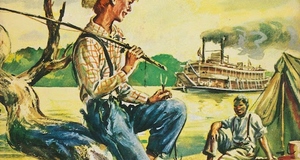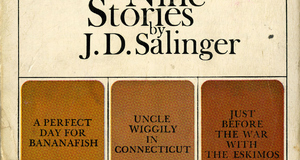The Father-Son Relationship of Jim and Huck in Mark Twain's Adventures of Huckleberry Finn
By
2014, Vol. 6 No. 11 | pg. 1/2 | »
KEYWORDS:
Since its publication in 1884, Mark Twain’s Adventures of Huckleberry Finn has been construed to have numerous meanings, many of them controversial or unfounded, and the relationship of Huckleberry Finn and Jim in Twain’s book has not been exempt from this scrutiny and radical interpretation. Two scholars, Leslie Fiedler and Axel Nissen, have taken a drastic step in explaining the meaning and motives behind Huck and Jim’s relationship. In their controversial essays, Fiedler and Nissen advocate that Huck Finn and Jim develop a romantic relationship based on homosexual feelings and affections; however, it may be clearly discerned from the text of Huck Finn that this reading of the book is tenuous and that, instead, readers can more accurately understand Jim and Huck’s relationship to function as an adopted father and son who gradually grow in their understanding of and respect for each other as equal human beings. Though Fiedler and Nissen have made some strong claims in their essays, it is evident that Huck and Jim’s relationship is not based on homosexual tendencies or feelings and is rather motivated by far different reasons. The various arguments put forward by Fiedler and Nissen can be refuted through examples of Huck’s and Jim’s characteristics, personalities, and actions in the book and shown to actually be a demonstration of their familial, parent-child relationship. Through his essay, Fiedler communicates the message that Huck Finn “celebrate[s] the mutual [homosexual] love of a white man and a colored” (49) and early on in his essay, Nissen posits that “Huck and Jim negotiate an uncommon type of romantic friendship across barriers of race and generation” (60). Nissen uses specific instances in Huck Finn to support his position. One area of the book he refers to is the terms of endearment, such as “honey” and “chile” (Twain 112), that Jim calls Huck. Although Nissen maintains that this type of affectionate language must necessarily prove that Jim has romantic feelings toward Huck, there is plenty of room for other, more convincing, interpretations. It is more plausible that Jim is instead viewing young Huck as his paternal responsibility and is treating him in a fatherly, affectionate way that prompts the use of these expressions of fondness. Chadwick Hansen appositely points out that the word “honey” was “the commonest word used by an adult southern Negro of either sex for a white child of either sex toward whom the Negro was at all well disposed” (54) and that Jim uses this term not only for Huck but also for Tom Sawyer later on. Nissen also declares that “Jim’s violent reaction” toward Huck after the episode in the fog “can[not] be read otherwise than as a genuine feeling of hurt and betrayal based on genuine feelings of affection for Huck” (70-1). This assertion is overly speculative, and it is not too literal to read Jim’s behavior simply as a surprised, incredulous response as a friend to Huck’s unjust treatment of Jim after all they have been through together as comrades in flight. A third area of controversy that Nissen brings up in his essay is that near the end of the book “Jim is sidetracked from his goal of securing freedom for himself and his family by the responsibility he feels toward another person close to his heart—namely, Huck” and that Jim keeps Pap’s death a secret from Huck until the book’s closing scene out of the fear of “losing Huck’s companionship and affection” (85). On the contrary, a much more accurate explanation for Jim’s delay in revealing Pap’s fate to Huck is based on Jim’s goodness and sensitivity of heart toward the young boy who has become like a son to him. As a caring father figure for Huck, Jim makes an effort to keep Huck from having to witness anything so “gashly” (Twain 50) and disturbing as a dead body, and his hesitancy in disclosing the identity of the body as Huck’s father is simply out of a genuine concern for Huck: seeing a dead body would have been graphic enough for an adolescent boy, but the knowledge of the body being his own father would have greatly heightened the trauma involved. Tuire Valkeakari aptly explains that Jim’s decision to withhold this information from Huck allows Jim “to protect the fatherless boy as unselfishly as if Huck were his own son . . . without Huck having to consciously face or admit the process of substitution” (35). As Huck Finn opens, Huck and Jim’s relationship lacks the trust and love that is necessary for a healthy father-son relationship and their roles are very different from what they will ultimately become. For the majority of the book’s events, Jim is portrayed as the runaway slave of Miss Watson who teams up with Huck Finn, and he is at first shown to be similar to that of a stereotypical black slave characterized, Hansen explains, by the simple-minded, superstitious, “comic stage Negro . . . who is often the butt of low comedy, and whose essential quality is his insensitivity to mental or to physical pain” (46). Indeed, Jim becomes the object of Huck and Tom’s humor early in the book’s second chapter as well as several more times throughout the book. When Huck is introduced to us, he has not yet realized the human value of Jim and treats him merely as an easily manipulated person of whom he can take advantage. Besides the numerous pranks Huck plays on Jim, Huck uses Jim as his personal fortune-teller and superstition adviser. After his dramatic escape from Pap’s cabin in the woods, Huck meets Jim on Jackson’s Island, at which time the two forge an unlikely camaraderie, though they still have yet to come to a common understanding of one another. Because a close familial relationship between a white boy and a black slave like Huck and Jim necessarily poses some major problems, the two experience a gradual progression as they grow in their understanding and realization of each other’s worth and value. Ultimately Huck and Jim come to share a unique relationship characterized by the affection and care between a father and child. Because a close familial relationship between a white boy and a black slave like Huck and Jim necessarily poses some major problems, the two must experience a gradual progression as they grow in their understanding and realization of each other’s worth and value. As they interact, both Huck and Jim get acquainted with the valuable qualities present in each other’s character and accept one another as adopted family members. Huck, as already mentioned, initially views Jim as a less-than-equal slave and feels justified to exploit Jim’s gullibility and simplicity for his own entertainment; however, with each new joke or trick he plays on Jim, Huck is struck with an increasing sense of shame and penitence for what he has done, gradually acquiring an understanding of Jim’s equality and value as a human being and father figure. In Andrew Solomon’s words, the “development [of their closeness] is clearly indicated by the progression of the three practical jokes Huck plays on Jim” (22). The first joke, when Huck and Tom hang Jim’s hat above him, causing Jim’s superstitious suspicions to rise immensely, establishes Jim’s foolishness and inferiority in Huck’s mind and provides a good laugh for the two boys. The second one, however, when Huck puts a dead rattlesnake in Jim’s bed on the island, attracting the snake’s mate to come and leave Jim with a deadly bite, is a serious situation, and Huck begins to feel a prick of sorrow and guilt when his “practical joke” invites the possibility of death. Occurring further along in Huck and Jim’s journey and relationship, Huck’s third prank, making Jim think that the episode in the fog was just a dream, leaves no room for amusement, and Jim’s unexpected, somber response shakes Huck out of any lingering state of denial or ignorance regarding Jim’s real, human qualities as an equal and intelligent individual. When Jim rightly calls Huck “trash” for treating him in that way, Jim assumes the role of admonishing parent, and Huck meekly submits and humbles himself to Jim, who “made [Huck] feel so mean [he] almost kissed his foot to get him to take it back” (Twain 84). Another set of incidents that alerts Huck to Jim’s natural, human characteristics is Jim’s attitude toward his wife and children, whom he is forced to leave behind at the point of his flight from Miss Watson. At first, Jim’s boldness and insistence that he would someday buy his family out of slavery or “get an Ab'litionist to go and steal them” (Twain 86) astonishes Huck and lowers Jim’s standing in Huck’s eyes, but later on, when Jim is brokenhearted over the loss of his family and his past harsh treatment of his deaf daughter, Huck begins to grasp the significance of Jim’s humanity and realizes that Jim “cared just as much for his people as white folks does for their'n” (Twain 150). Huck finally starts to understand that black people are just as natural as the white, and that they have their equal rights, familial affections, and “natural human desires” (Joshi 3) just as their white counterparts do. For Huck, this is another step toward gaining that valuable friendship and familial relationship with Jim. Following the escape from the Wilks’ and the subsequent recapturing by the Duke and the King, Huck begins to view Jim as a fatherly confidant and decides to have a “long gabble . . . and [tell] Jim everything” (Twain 201). Although Huck has a habit of lying “to conceal and preserve his private life” (Knoper 128) from the public world, he doesn’t mind telling Jim everything, thereby demonstrating his newfound trust and confidence in Jim. Huck’s final decision to “go to hell” (Twain 206) rather than betray Jim comes after Huck hears of Jim’s capture, mourns over his loss, and recalls the kindness and unselfishness Jim has displayed toward Huck as a father would toward a son, and as Carol Freedman says, “he comes to a more heart-felt conception of what’s right” (103).Continued on Next Page » Suggested Reading from Inquiries Journal
Inquiries Journal provides undergraduate and graduate students around the world a platform for the wide dissemination of academic work over a range of core disciplines. Representing the work of students from hundreds of institutions around the globe, Inquiries Journal's large database of academic articles is completely free. Learn more | Blog | Submit Latest in Literature |



















